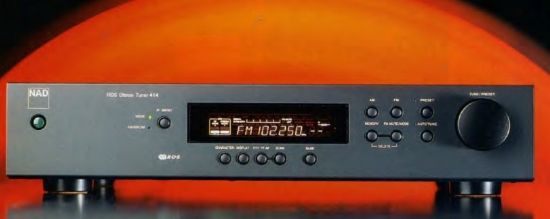NAD 414 Tuner
The famous English firm has produced an excellent device, massive and voluminous, which gives an impression of solidity and severity in the design. Radio station tuning is made not by buttons, but a big rotating handle. This somehow reminds old, good radios, but unlike them the handle does not rotate an adjustable capacitor, but switches quite a modern frequency synthesizer, creating only the illusion of smooth turning. This round handle in other mode switches presets, which are pre-programmed into the memory of stations' frequency. The tuner is well-equipped functionally, it gives the possibility to scan presets, has high-frequency attenuator, signal strength indicator in the form of linear scale on the display, switch of bandwidth of VHF tract. Fine adjustment is indicated firstly by maximum of signal strength and, secondly, by lighting up inscription. All these functions significantly simplify setup allow you to optimize the reception. By the way, the tuner made the optimization of parameters of the reception by itself, indicating everything that it did with service inscriptions in the left part of the display, which show whether local or distant reception is on, stereo turns on automatically and so on. Stereo reception mode is turned on automatically at a sufficient signal level. I will remind that even in theory level should be 18 dB higher for stereo reception than for mono reception. For example, if the sensitivity at mono reception is 1 μV, it will be about 10 μV at stereo reception, and usually even lower. Noise-rejection device turns on together with stereo mode while structural adjustments in frequencies, locking low-frequency outputs in any cases if only the tuner is not tuned exactly to the radio signal. In the mono reception mode and at manual setup this device turns off in order not to miss the signal of a weak station. The titles will be played back on the display after the setup on the frequency of radio station. They are entered into the display letter by letter, and letters are selected from the alphabet by rotating the setup handle. The tuner is equipped with RDS system, which allows you, in addition to indication on the display, name of station and type of the transferred program, to know traffic information and alternative frequencies, on which the same program will be transferred (these functions are usually used in car radio), and also to read radio text and check time by standard time signal, transferring by the radio stations (the time is played on the display during one minute). Parameters of the tuner NAD 414 turned out to be higher than ever in VHF-band, exactly they create the name to the firm. Especially a huge selectivity amazed, which almost guarantees the lack of interference at VHF-reception. This was confirmed while the reception of VHF stations from air. The tuner perfectly worked with both supplied dipole room antenna and outdoor one, providing a brilliant quality of sound. AM tract of the tuner caused conflicting emotions. Its parameters are bad for traditional tuners - we mean a low selectivity. At the same time signal/noise ratio, being measured at quite a strong signal of 1 mV, turned out to be surprisingly high. It is not a mistake or a type - 72 dB! How the engineers could achieve it is a mystery. And another mystery: if they can do it, why did not they care about the selectivity? Leaving these mysteries unsolved, let's listen what is happening at the real reception from air. The receipt on the attached frame turned out to be good, there are little interference and no background at all. It didn't appear at the connection of outdoor antenna, and local stations went almost with the same quality as on VHF. But at the reception of less powerful stations it started to be followed by interference from the powerful ones (i.e. you hear both programs at the same time). Here is the result of the lack of selectivity. Conclusion: the tuner in the range of medium waves is good only for reception of the most powerful stations.




